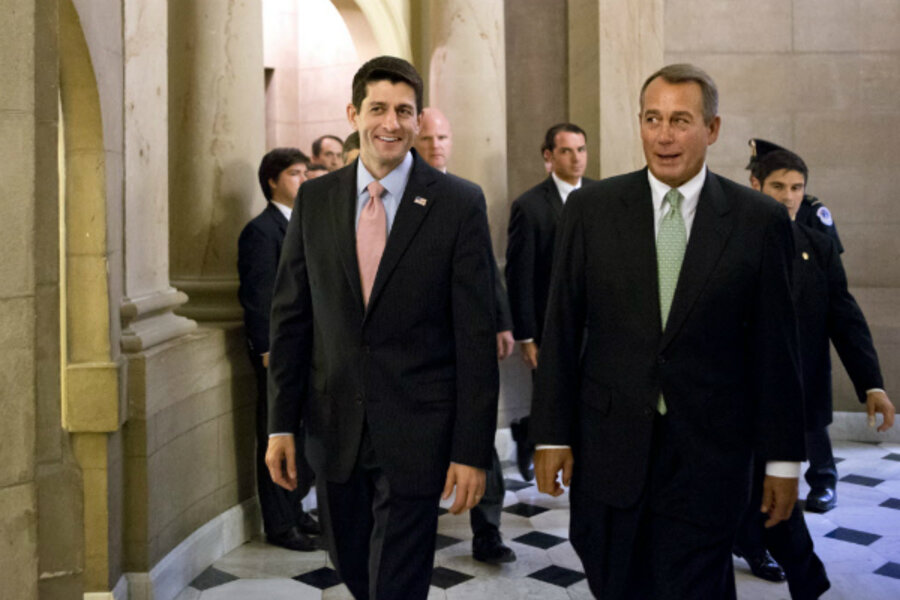Congress takes first step to avert a government shutdown
Loading...
| Washington
Congress took its first step toward making sure the government’s lights don’t go out when the fiscal year ends on Sept. 30, but no one on Capitol Hill was declaring victory.
The House approved government funding for six months into the 2013 fiscal year on Thursday afternoon through what’s known as a continuing resolution, or “CR,” with bipartisan support that will keep the US government chugging along for six months, at a rate of spending just .6 percent higher than the current year.
The measure passed on a 329 to 91 vote, with 70 Republicans and 21 Democrats opposed to the measure. It will be handed up to the Senate where it is expected to pass next week.
The reason for the continuing resolution is a failure by Congress to pass the 12 annual appropriations bills that fund the federal government. The House passed half; the Senate, none. With these bills unresolved – and the fiscal year set to end on Sept. 30 – the two houses announced a deal before the August recess that would keep the government running into 2013.
But by Thursday afternoon, the mood on Capitol Hill was more one of recrimination.
“We’re really in bad shape if all we can say for ourselves is that we’re keeping the government open,” said Rep. David Price (D) of North Carolina on the House floor Thursday.
That dour feeling extended even to the House’s most conservative Republicans, several of whom voted against the measure after making the initial push for the six-month spending measure during July.
In a surprise move, some of Congress’s most conservative lawmakers joined a call by Sen. Jim DeMint (R) of South Carolina to move a six-month CR with the additional step of agreeing to spending level at an annual rate of $1.047 trillion before the August recess.
That’s the level specified by last summer’s debt-ceiling deal and $19 billion more than the budget that House Republicans passed last Spring.
Why push for a CR, then? The goal, they say, is to avoid the need to pass government funding in a lame-duck session already required to made decisions on some $560 billion in expiring tax cuts and mandatory spending cuts, known as the 'fiscal cliff.'
Before the GOP’s most conservative wing made its push for a CR, conventional wisdom stood expected Congress to pass only a three-month funding bump.
In the haze of a lame duck session after the November elections, House and Senate conservatives feared, they’d be forced to swallow a vote on a massive bill that would include funding the government and, perhaps, tax increases. By moving government funding into 2013, they think they’ve cleared the potential for such an outcome.
The “strategic principle is we don’t want to have a lame-duck Congress and hopefully a lame-duck president making these decisions,” about taxes and spending, said Rep. Tim Huelskamp (R) of Kansas.
But some Republicans still defected for a variety of reasons. The CR included some $6 billion in funding for disasters that was not offset by spending cuts, for example, in addition to a straightforward extension of welfare spending (formally known as Temporary Assistance for Needy Families, or TANF), both of which conservatives find objectionable.
Rep. Raul Labrador (R) of Idaho said he offered his support to the measure because he thought it would eliminate the need for a lame-duck session altogether. Without that promise, he opposed the measure.
The Club for Growth, a conservative advocacy group dedicated to slashing government spending, urged a “no” vote on the measure in part because it “provides only short-term funding for the government so that politicians can leave Washington to avoid politically sensitive events.”
But even for Republicans with ideological qualms – and the threat of a blot on their conservative voting records – in the balance, the measure survived for a vote next week in the Senate.
Only some 50 days out from an election, Rep. Steve Southerland (R) of Florida sounded what might have been a slogan for lawmakers who held their nose and took the plunge.
“Discretion,” the freshman lawmaker told reporters, “is the better part of valor.”







